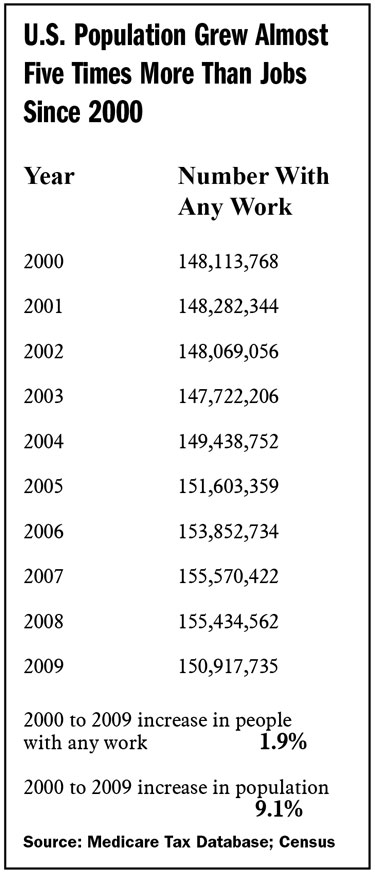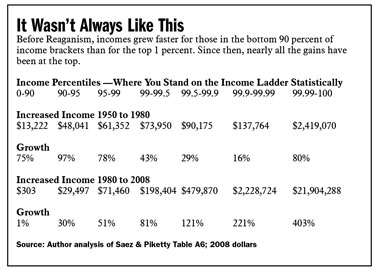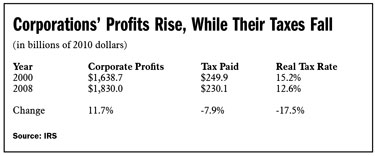For three decades the United States has conducted a massive economic experiment, testing a theory known as supply-side economics. The theory goes like this: Lower tax rates will encourage more investment, which in turn will mean more jobs and greater prosperity — so much so that tax revenues will go up, despite lower rates. The late Milton Friedman, the libertarian economist who wanted to shut down public parks because he considered them a form of socialism, promoted this strategy. Ronald Reagan embraced Friedman’s ideas and made them into policy when he was elected president in 1980.
For the past decade, we have doubled down on this theory of supply-side economics with the tax cuts sponsored by President George W. Bush in 2001 and 2003, which President Obama has agreed to continue for two years.
 You’d think that whether this grand experiment worked would be settled after three decades. You’d think the practitioners of the dismal science of economics would look at their demand curves and the data on incomes and taxes and pronounce a verdict, the way Galileo and Copernicus did when they showed that geocentrism was a fantasy because Earth revolves around the sun. But economics is not like that. It is not like physics with its laws and arithmetic with its absolute values.
You’d think that whether this grand experiment worked would be settled after three decades. You’d think the practitioners of the dismal science of economics would look at their demand curves and the data on incomes and taxes and pronounce a verdict, the way Galileo and Copernicus did when they showed that geocentrism was a fantasy because Earth revolves around the sun. But economics is not like that. It is not like physics with its laws and arithmetic with its absolute values.
Tax policy is something the Framers left to politics. And in politics, the facts often matter less then who has the biggest bullhorn. The Mad Men who once ran campaigns featuring doctors extolling the health benefits of smoking are now busy marketing the dogma that tax cuts mean broad prosperity, no matter what the facts show.
As millions of Americans prepare to file their annual taxes, they do so in an environment of media-perpetuated myths about taxes and our economy. Here are a few points to consider as you contemplate that tax return. (All figures are inflation adjusted.)
1. Poor Americans do pay taxes.
Gretchen Carlson, the Fox News host, said last year that “47 percent of Americans don’t pay any taxes.” John McCain and Sarah Palin both said similar things during the 2008 campaign about the bottom half of Americans.
Ari Fleischer, the former Bush White House spokesman, once said that “50 percent of the country gets benefits without paying for them.”
Actually, they pay lots of taxes — just not lots of federal income taxes.
Data from the Tax Foundation shows that in 2008, the average income for the bottom half of taxpayers was $15,300. This year the first $9,350 of income is exempt from taxes for singles and $18,700 for married couples, just slightly more than in 2008.
That means millions of the poor do not make enough to owe income taxes. But they still pay plenty of other taxes, including federal payroll taxes. Between gas taxes, sales taxes, utility taxes, and other taxes, no one lives tax-free in America.
When it comes to state and local taxes, the poor bear a heavier burden than the rich in every state except Vermont — that’s according to the Institute on Taxation and Economic Policy, calculated from official data. In Alabama, for example, the burden on the poor is more than twice that of those with incomes in the top 1 percent. The one-fifth of Alabama families making less than $13,000 in annual income pay almost 11 percent of their income in state and local taxes, compared with less than 4 percent for those who make $229,000 or more.
2. The wealthiest Americans don’t carry the burden.
This is one of those oft-used canards. U.S. Sen. Rand Paul, the Tea Party favorite from Kentucky, told David Letterman recently that “the wealthy do pay most of the taxes in this country.”
The internet is awash with statements that the top 1 percent pays, depending on the year, 38 percent or more than 40 percent of taxes.
It’s true that the top 1 percent of wage earners paid 38 percent of the federal income taxes in 2008 (the most recent year for which data is available). But people forget that the income tax is less than half of federal taxes and only one-fifth of taxes at all levels of government.
Social Security, Medicare, and unemployment insurance taxes (known as payroll taxes) are paid mostly by the bottom 90 percent of wage earners. That’s because once you reach $106,800 of income, you pay no more for Social Security, though the much smaller Medicare tax applies to all wages. Warren Buffett pays exactly the same amount of Social Security taxes as someone who earns $106,800.
3. In fact, the wealthy are paying less taxes.
The Internal Revenue Service issues an annual report on the 400 highest income-taxpayers. In 1961, there were 398 taxpayers who made $1 million or more, so I compared their income tax burdens from that year to 2007.
Despite skyrocketing incomes, the federal tax burden on the richest 400 has been slashed, thanks to a variety of loopholes, allowable deductions, and other tools. The actual share of their income paid in taxes, according to the IRS, is 16.6 percent. Adding payroll taxes barely nudges that number.
Compare that to the vast majority of Americans, whose share of their income going to federal taxes increased from 13.1 percent in 1961 to 22.5 percent in 2007.
(By the way, during seven of the eight Bush years, the IRS report on the top 400 taxpayers was labeled a state secret, a policy that Obama overturned almost instantly after his inauguration.)
 4. Many of the very richest pay no current income taxes at all.
4. Many of the very richest pay no current income taxes at all.
John Paulson, the most successful hedge fund manager of all, bet against the mortgage market one year and then bet with Glenn Beck in the gold market the next. Paulson made himself $9 billion in fees in just two years. His current tax bill on that $9 billion? Zero.
Congress lets hedge fund managers earn all they can now and pay their taxes years from now.
In 2007 Congress debated whether hedge fund managers should pay the top tax rate that applies to wages, bonuses, and other compensation for their labors, which is 35 percent. That tax rate starts at about $300,000 of taxable income — not even pocket change to Paulson, but almost 12 years of gross pay to the median-wage worker.
The Republicans and a key Democrat, Sen. Charles Schumer of New York, fought to keep the tax rate on hedge fund managers at 15 percent, arguing that the profits from hedge funds should be considered capital gains, not ordinary income, which got a lot of attention in the news.
What the news media missed is that hedge fund managers don’t even pay 15 percent, at least not currently. So long as they leave their money, known as “carried interest,” in the hedge fund, their taxes are deferred. They pay taxes only when they cash out, which could be decades from now for younger managers. How do these hedge fund managers get money in the meantime? By borrowing against the carried interest, often at absurdly low rates — currently about 2 percent.
Lots of other people live tax-free too. I have Donald Trump’s tax records for four years early in his career. He paid no taxes for two of those years. Big real-estate investors enjoy tax-free living under a 1993 law President Clinton signed. It lets “professional” real-estate investors use paper losses like depreciation on their buildings against any cash income, even if they end up with negative incomes like Trump.
Frank and Jamie McCourt, who own the Los Angeles Dodgers, have not paid any income taxes since at least 2004, their divorce case revealed. Yet they spent $45 million in one year alone. How? They just borrowed against Dodger ticket revenue and other assets. To the IRS, they look like paupers.
In Wisconsin, Terrence Wall, who unsuccessfully sought the Republican nomination for U.S. Senate in 2010, paid no income taxes on as much as $14 million of recent income, his disclosure forms showed. Asked about his living tax-free while working people pay taxes, he had a simple response: Everyone should pay less.
5. Surprise! Since the Reagan administration, only the wealthy have gained significant income.
The Heritage Foundation, the Cato Institute, and similar conservative marketing organizations tell us relentlessly that lower tax rates will make us all better off.
“When tax rates are reduced, the economy’s growth rate improves and living standards increase,” according to Daniel J. Mitchell, an economist at Heritage until he joined Cato. He says that supply-side economics is “the simple notion that lower tax rates will boost work, saving, investment, and entrepreneurship.”
When Ronald Reagan was elected president, the top rate paid on the very highest income was 70 percent. He cut it to 50 percent and then 28 percent starting in 1987. It was raised by George H.W. Bush and Clinton and then cut by George W. Bush. The top rate is now 35 percent.
Since 1980, when President Reagan won election promising prosperity through tax cuts, the average income of the vast majority — the bottom 90 percent of Americans — has increased a meager $303, or 1 percent. Put another way, for each dollar the vast majority of people made in 1980, in 2008 their income was up to $1.01.
Those at the top did much better. The top 1 percent’s average income more than doubled, to $1.1 million, according to an analysis of tax data by economists Thomas Piketty and Emmanuel Saez. The really rich, the top 10th of 1 percent, enjoyed almost $4 in 2008 for each dollar they made in 1980.
The 300,000 highest-earning Americans now enjoy almost as much income as the bottom 150 million, the data show.
6. When it comes to corporations, the story is much the same — less taxes.
Corporate profits in 2008, the latest year for which data is available, totalled $1,830 billion, up almost 12 percent from $1,638 in 2000. Yet even though corporate tax rates have not been cut, federal revenue from corporate income taxes fell from $249 billion to $230 billion — an 8 percent decline, thanks to a number of loopholes. The official 2010 profit numbers have not yet been added up by the government, but the amount paid in corporate taxes has been: In 2010 they fell further, to $191 billion — a decline of more than 23 percent compared with 2000.
 7. Some corporate tax breaks destroy jobs.
7. Some corporate tax breaks destroy jobs.
Despite all the noise about how America has the world’s second highest corporate tax rate, the actual taxes paid by corporations are falling because of the growing number of loopholes and companies shifting profits to tax havens like the Cayman Islands.
And right now America’s corporations are sitting on close to $2 trillion in cash that is not being used to build factories, create jobs, or do anything else, but instead is acting as an insurance policy for managers unwilling to take the risk of actually building the businesses they are paid so well to run. That cash hoard, by the way, works out to nearly $13,000 per taxpaying household.
A corporate tax rate that is too low actually destroys jobs. That’s because a higher tax rate encourages businesses to keep money in the business and reinvest, rather than pull it out as profit on which they’d have to pay high taxes.
The 2004 American Jobs Creation Act, which passed with bipartisan support, allowed more than 800 companies to bring profits that were untaxed but overseas back to the United States. Instead of paying the usual 35 percent tax, the companies paid just 5.25 percent.
The companies said bringing the money home — “repatriating” it, they called it — would mean lots of jobs. Sen. John Ensign, the Nevada Republican, put the figure at 660,000 new jobs.
Pfizer, the drug company, was the biggest beneficiary. It brought home $37 billion, saving $11 billion in taxes. Almost immediately it started firing people. Since the law took effect, it has let 40,000 workers go. In all, it appears that at least 100,000 jobs were destroyed.
Now Congressional Republicans and some Democrats are gearing up again to pass another tax holiday, promoting a new Jobs Creation Act. It would affect 10 times as much money as the 2004 law.
 8. Republicans like taxes too.
8. Republicans like taxes too.
Reagan signed into law 11 tax increases, targeted at people down the income ladder. His administration and the Washington press corps called the increases “revenue enhancers.” Among other things, Reagan hiked Social Security taxes so high that by the end of 2008, the government collected more than $2 trillion in surplus tax.
George W. Bush signed a tax increase, too, in 2006, despite his written ironclad pledge to never raise taxes on anyone. It raised taxes on teenagers by requiring money-earning kids up to age 17 to pay taxes at their parents’ rate, which would almost always be higher than the rate they would otherwise pay. That story ran buried inside The New York Times one Sunday but nowhere else.
In fact, thanks to Republicans, one in three Americans will pay higher taxes this year than they did last year.
First, some history. In 2009, Obama pushed his own tax cut — for the working class. He persuaded Congress to enact the Making Work Pay Tax Credit. Over the two years 2009 and 2010, it saved single workers up to $800 and married heterosexual couples up to $1,600, even if only one spouse worked. The top 5 percent or so of taxpayers were denied this tax break.
The Obama administration called it “the biggest middle-class tax cut” ever. Yet last December the Republicans, poised to regain control of the House of Representatives, killed Obama’s tax credit while extending the Bush tax cuts for two more years — a policy Obama agreed to.
By doing so, Congressional Republican leaders increased taxes this year on a third of Americans, virtually all of them the working poor.
As a result, of the 155 million households in the tax system, 51 million will pay an average of $129 more this year. That is $6.6 billion in higher taxes for the working poor, the nonpartisan Tax Policy Center estimated.
In addition, the Republicans changed the rate of workers’ FICA contributions, which finances half of Social Security. The result: If you are single and make less than $20,000, or married and make less than $40,000, you lose under this plan.
But the top 5 percent, people who make more than $106,800, will save $2,136 ($4,272 for two-career couples).
9. Other countries do it better.
We measure our economic progress, and our elected leaders debate tax policy, in terms of a crude measure known as gross domestic product. The way the official statistics are put together, each dollar spent buying solar energy equipment counts the same as each dollar spent investigating murders.
We do not give any measure of value to time spent rearing children or growing our own vegetables or to time off for leisure and community service.
And we do not measure the economic damage done by shocks, such as losing a job, which means not only loss of income and depletion of savings, but loss of health insurance, which a Harvard Medical School study found results in 45,000 unnecessary deaths each year in this country.
Compare that to Germany, one of many countries with a smarter tax system and smarter spending policies.
Germans work less, make more per hour, and get much better parental leave than Americans, many of whom get no fringe benefits such as health care, pensions, or even a retirement savings plan. By many measures the vast majority live better in Germany than in America.
To achieve this, unmarried workers in Germany pay on average 52 percent of their income in taxes. Americans average 30 percent, according to the Organisation for Economic Co-operation and Development.
At first blush the German tax burden seems horrendous. But in Germany (as well as Britain, France, Scandinavia, Canada, Australia, and Japan), tax-supported institutions provide many of the things Americans pay for with after-tax dollars. Buying wholesale rather than retail saves money.
A proper comparison would take the 30 percent average tax on American workers and add their out-of-pocket spending on health care, college tuition, and fees for services and compare that with taxes that the average German pays. Add it all up and the combination of tax and personal spending is roughly equal in both countries, but with a large risk of catastrophic loss in America and a tiny risk in Germany.
Americans take on $85 billion of debt each year for higher education, while college is financed by taxes in Germany, and tuition is cheap or free in other modern countries. While soaring medical costs are a key reason that bankruptcy in America has increased 15 times faster than population growth since 1980, no one in Germany or the rest of the modern world goes broke because of accident or illness. And child poverty in America is the highest among modern countries — almost twice the rate in Germany, which is close to the average of modern countries.
On the corporate tax side, the Germans encourage reinvestment at home and the outsourcing of low-value work, like auto assembly, and German rules tightly control accounting so that profits earned at home cannot be made to appear as profits earned in tax havens.
Adopting the German system is not the answer for America. But crafting a tax system that benefits the vast majority, reduces risks, provides universal health care and focuses on diplomacy rather than militarism abroad (and at home) would be a lot smarter than what we have now.
Here is a question to ask yourself: We started down this road with Reagan’s election in 1980 and upped the ante in this century with George W. Bush. How long does it take to conclude that a policy has failed to fulfill its promises?
And as you think of that, keep George Washington in mind. When he fell ill, his doctors followed the common wisdom of the era. They cut him and bled him to remove bad blood. As Washington’s condition grew worse, they bled him more. And like the mantra of tax cuts for the rich, they kept applying the same treatment until they killed him.
Luckily we don’t bleed the sick anymore, but we are bleeding our government to death.
David Cay Johnston is a columnist for tax.com and teaches at Syracuse University College of Law and Whitman School of Management. He has been called the “de facto chief tax enforcement officer of the United States” because his reporting in The New York Times shut down many tax dodges and schemes, just two of which were valued by Congress at $260 billion. Johnston received a 2001 Pulitzer Prize for exposing tax loopholes and inequities. He wrote two bestsellers on taxes, Perfectly Legal and Free Lunch. His new book, out later this year, is The Fine Print, revealing how big business, with help from politicians, abuses plain English to rob you blind.











